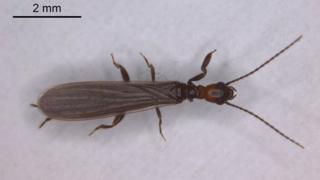Webspinners: New order of insects sets up home in UK
 Image copyright Br J Ent Nat Hist
Image copyright Br J Ent Nat Hist The UK has a new order of insects, thanks to stowaways that set up home in the warmth of a glasshouse.
The silk-spinning insects, known as webspinners, seemingly hitched a ride on imported plants.
They survived undetected until a botanist at RHS Garden Wisley, Surrey, noticed webs appearing on the roots of orchids.
The creepy crawlies were subsequently identified as the first “full thriving colony” of webspinners in the UK.
Since webspinners are unlikely to survive outdoors, their arrival is “neither good nor bad news”, rather “interesting”, said principal entomologist, Dr Andy Salisbury.
The colony came to light last summer when several mystery insects and their young were found inside silk webs in the orchid collection at the garden.
They were subsequently identified as webspinners in what appears to be the first discovery of an established colony in the UK.
Dr Salisbury said as a tropical insect they are unlikely to survive outdoors in Britain, but may be found elsewhere in plant collections inside glasshouses.
While a few of the insects have been intercepted in the past on imported plants and stone, this is the first time a “full thriving colony” has been discovered.
It is not clear when the webspinners first arrived, but they do not appear to be causing any damage to living plants.
Scientists say the insects are “exotic” rather than “invasive”.
“The difference is that the former means they came from somewhere else, by human trade in this case, but they are not highly competitive with native species,” said Janice Edgerly-Rooks, professor of biology at Santa Clara University. “They do not damage the ecosystem or ecological community of the new region.”
Matt Shardlow, chief executive of the charity Buglife, said the find highlighted the risk of imported insects that can survive in the British climate becoming established.
He said there had been reports of crickets, grasshoppers, moths, beetles and slugs emerging from the soil of imported plants.
“It’s an indication of some of the stuff that is arriving and the unpredictability of what’s going to come next,” he said.
How many insects are found in the UK?
The UK has more than 20,000 species of insect, divided into more than 20 orders, such as dragonflies, butterflies and moths, and beetles.
The last new order of British insects – stick insects – was added about 100 years ago.
Globally, well over one million species of insect have been described to date. Recent studies have suggested there is an ongoing dramatic decline in insect populations around the world.
Insect life is at the bottom of the food chain and underpins much of life on Earth.
What are webspinners?
The species found in Surrey (Aposthonia ceylonica) grows to about 1cm in length and lives on the hanging roots of tropical plants like orchids and bromeliads.
All webspinners produce silk, which they use to make the tunnels and chambers.
They feed on leaf litter, moss, bark and lichen.
Males leave the home colony as soon as they become adults to find a mate and never eat.
In some species, the female will eat the male after mating, but either way, the male does not survive for long.
Where are they found?
Most webspinners are tropical or subtropical with a few species found in the Mediterranean, but not in cooler climates.
No species is known to occur naturally in the UK.
Full details of the discovery are reported in the British Journal of Entomology and Natural History.
Follow Helen on Twitter.


